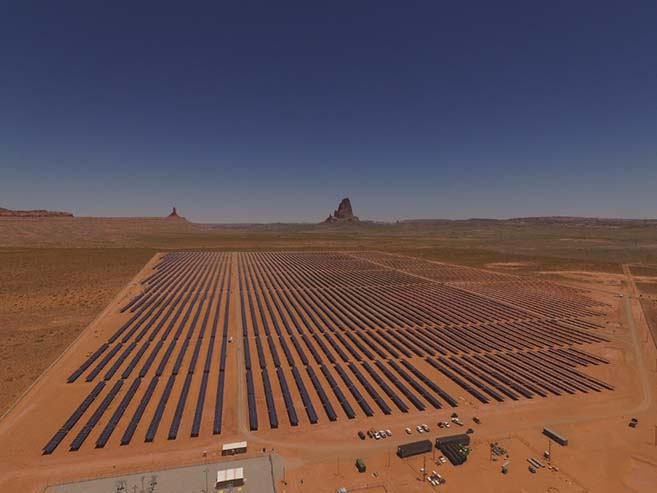
- Details
- By Elyse Wild
- Energy | Environment
Green energy could soon take hold on the largest Indian Reservation in the United States, per a recently signed agreement between the Navajo Tribal Utility Authority (NTUA) and sustainable energy giant AVANGRID (NYSE: AGR).
The Conneticut-based company and NTUA signed a memorandum of understanding to explore opportunities to develop up to 1 gigawatt of solar, wind and backup battery energy on the 27,400 square-mile Navajo Nation.
The initiative will see NTUA and AVANGRID collaborating to study the feasibility of developing affordable renewable energy solutions to drive economic development and create jobs on the Navajo Nation.
Approximately 30—40% of Navajo Nation homes lack modern utilities such as water and electricity. NTUA was launched as a tribally-owned nonprofit in 1959 to address the absence of utilities on the reservation through the operation, maintenance, and expansion of utilities, including low-cost off-grid residential solar services for Navajo residents.
AVANGRID — which owns $40 billion in assets and operates in 24 states — brings to the partnership a track record of commitment to the environment. In 2020, it was named to Forbes Just 100 — a list of America’s most responsible corporations — topping the utility category in recognition of its commitment to the environment and the communities in which it works. As well it was named among the World’s Most Ethical Companies in 2022 for the fourth consecutive year by the Ethisphere Institute.
“NTUA Generation has been working diligently to explore renewable energy development opportunities on the Navajo Nation with the promise of new jobs and clean green energy,” NTUA General Manager Walter Haase said in a statement. “We do believe the partnership we have with AVANGRID will advance clean green energy development on the Navajo Nation and will help provide benefits to the communities served by NTUA. We look forward to the progress this partnership will bring.”
According to reporting by the Albuquerque Journal, while all projects built through the partnership would be joint ventures, NTUA will maintain at least 51% majority ownership to retain tribal sovereignty and control.
NTUA has developed two solar farms on the reservation’s Arizona side in recent years, in 2017 and 2019, totaling 55MW of renewable generation. The utility authority’s latest project — a 70 MW Red Mesa Tapaha Solar Farm in Utah — came online in March. The Albuquerque Journal noted the Red Mesa Project employed nearly 300 people during its construction.
The partnership is the latest in the Navajo Nation’s multi-pronged efforts to facilitate an equitable transition from the coal industry.
Navajo Nation struggles with chronic unemployment, which hovers at 48%, according to the Navajo Department of Agriculture. Tribal unemployment has been accelerated in recent years by power plant closures in the Four Corners region — including that of Navajo Generating Station and the coal mining operations that supplied it in 2019 and the San Juan Generating Station and its mining operations in 2022. The closers left unemployed Navajo plant workers with no new opportunities and meant tens of millions in revenue loss for the Navajo Nation.
One year after the closure of the Navajo Generation Station, plant co-owner Arizona Public Service announced a package of Just and Equitable Transition assistance to the Navajo Nation that will provide a minimum of $127 million to the tribe over the next ten years, plus major commitments to buy power from Navajo clean energy projects.
New projects generated from the NTUA and AVANGRID will create new jobs to soften the fallout of unemployment driven by plant closures, as well as provide opportunities for APS to fulfill its commitment.
And as the partners uncover sustainable energy opportunities, they will explore how those opportunities can benefit from The Inflation Reduction Act (IRA), the most significant climate investment in U.S. history. The IRA, signed into law by President Joe Biden in August 2022, includes increased loan guarantees for Tribal energy development from $2 billion to $20 billion.
U.S. Sen. Martin Heinrich (D-N.M.) called the partnership “transformative” and “exactly what the IRA was intended to encourage.
“AVANGRID and Navajo Nation’s commitment to exploring opportunities together to build clean energy projects will create new revenue streams and lower energy costs for New Mexicans,” Heinrich said. “I hope to see many more innovative partnerships in the coming months and years.”
